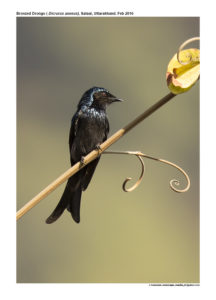Bronzed-drongo

Bronzed Drongo Dicrurus aeneus
Etymology :
- Dicrurus : Greek word dikros – forked; ouros –tailed { Forked tailed} : dikros – forked; ouros –tailed { Forked tailed}
- Aeneus : Latin word for Bronze colour
Vernacular Names : Hindi, Bi: Chhota kesraj, Ben: Chhota bhujanga, Nepal: Chaptia, Ta: Chinna kari kuruvi, Mal: Lalitakaka, Kan: Kanehu bhujanga, Mar: Kansya Kotwal
Distribution in India: Resident of Himalayan foothills, Eastern & Western Ghats and North East of India.
Description: Size of 23-24 cm. Nominate race is black, strongly glossed metallic blue-green or purple on crown, nape, mantle and breast especially spangled on throat; frontal band, chin and upper throat, flanks and belly to under tail-coverts deep matt black; rump often grey; slender tail, has central feathers black, glossed green, outer feathers black, depth of fork; iris dark reddish-brown or crimson; bill and legs black. Sexes similar in plumage, male a little larger than female.
Habitat: It is found in all kinds of forest or wooded habitats like broadleaf evergreen and moist-deciduous forest, mixed bamboo-jungle, secondary growth, forest edge, tea, coffee and rubber plantation and fruit gardens. Avoids open habitat.
Food Habits :It is insectivorous; some small vertebrates also taken. Consumes nectar also. Hawks winged insects, making short sallies, and often swooping close to ground, then looping back to same perch; also makes vertical sorties from treetop, diving back with wings held closed after a capture.
Breeding Habits: They breed in May-Jun. Nest built by both parents. Nest is a shallow irregular cup, extremely compact, of various materials like bark and decayed wood lined with dead strips of small vine, fine grass, fiber and a few dry bamboo leaves in India, well felted and cemented together, and fixed in branch fork with plant fibers and cobwebs; suspended in hammock fashion above ground in small fork of slender branch in outer part of tree, preferentially above water or track. Lays a clutch of 3- 4 eggs. The incubation is done by both sexes for period of 13 days. Both parents also feed the chicks.